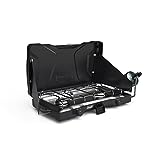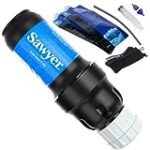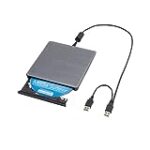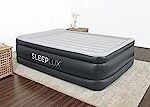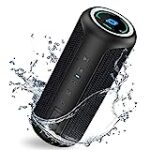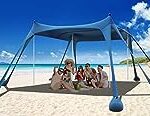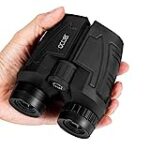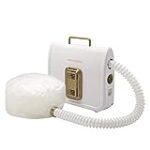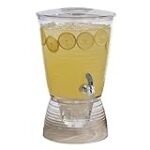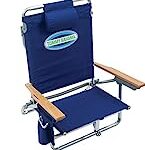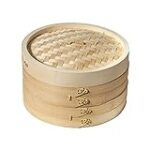🌅 Introduction
Welcome to our comprehensive camp stoves buying guide, where we bring you the best options for outdoor cooking adventures. Whether you’re a seasoned backpacker or a casual camper, finding the perfect camp stove is crucial for a hassle-free cooking experience. At [Your Company Name], we understand the importance of reliable and efficient camp stoves that cater to your specific needs. From lightweight backpacking stoves to powerful propane options, we’ve curated a selection that guarantees durability, convenience, and exceptional performance. Join us as we explore the world of camp stoves and help you make an informed decision for your next outdoor escapade.
🏆 Our Top 5
- PORTABLE: Easy addition to the campsite, picnic, roadside, and more
- TWO WIND GUARDS: Help shield and protect burners from wind
- HEAVY-DUTY LATCH: Easy to open and keeps the stove closed when not in use
- EASY TO CLEAN: Durable, chrome-plated grate is removable for easy cleanup
- IMPROVED KNOB ROTATION: For precise temperature and simmering control of two independently adjustable burners
- Duel Fuel - Compatible With Both Butane (Fuel Not Included) And Propane Fuel (Fuel Not Included), Operates On A Single Butane Cartridge 8 Oz Or A Propane Cylinder 16.4 Oz , Propane Converter Regulator Included
- Automatic Piezo Electric Ignition - Piezo-Electric Ignition That Eliminates The Use For Lighter/Matches In Order To Ignite Flame, No Need For Lighters Or Matches With This Stove
- Easy To Use - Our Gs-3400P Is Easy To Use With Adjustable Heat Dial And Automatic Piezo-Electric Ignition
- Safety Features - Built In Pressure Sensor Cartridge Ejection System And Gas Flow Cut Off Mechanism (Butane), Will Eject Cartridge When Irregular Pressure Is Detected
- PORTABLE: Lightweight and compact; included carry case makes it easy to bring to the campsite, picnic, roadside, and more
- PRECISE TEMPERATURE CONTROL: Single adjustable burner for precise temperature control
- EASY TO CLEAN: Porcelain-coated grate is removeable for quick cleanup; rust-proof aluminum burner
- LARGE BASE: For stable and easy stirring
- MATCHLESS LIGHTING: Instastart ignition for automatic, matchless lighting; 7,650 total BTUs of cooking power
- 2-IN-1 DESIGN: Use grill and stove at the same time; 130 sq. in. grilling area; stove fits a 10 in. pan
- COOKING POWER: Up to 20,000 total BTUs
- PRESSURE REGULATOR: Pressure-control technology provides consistent performance, even in extreme conditions
- PERFECTHEAT TECHNOLOGY: Offers more efficient cooking with less fuel
- 4 ADJUSTABLE BURNERS: For precise temperature control
- Portable: Built-in handle ensures easy transportation; heavy-duty latch secures the stove when not in use
- High Control: Independent adjustable burners with PerfectFlow and PerfectHeat technology for precise temperature
- Easy Ignition: Push-button Instastart ignition for matchless lighting
- Easy Maintenance: Removable chrome-plated grate & rust-resistant aluminized steel cooktop
- Wind Protection: Dual wind guards to shield and protect burners from wind
🤔 How to choose?
1. Fuel Type
When choosing a camp stove, one of the first decisions you’ll need to make is what type of fuel you want to use. There are several options available, each with its own advantages and disadvantages.
One popular choice is propane, which is known for its convenience and ease of use. Propane stoves are typically lightweight and compact, making them ideal for backpacking trips. They also provide a consistent flame and can be easily regulated for precise cooking. However, propane canisters can be bulky to carry and may not be readily available in remote areas.
Another option is butane, which is similar to propane but has a higher boiling point. This makes butane stoves more efficient in colder temperatures. However, butane canisters are also bulkier and may not be as widely available as propane.
If you prefer a more traditional approach, you might consider a liquid fuel stove. These stoves can run on a variety of fuels, such as white gas, kerosene, or diesel. Liquid fuel stoves are known for their reliability and versatility, as they can be used in a wide range of conditions. However, they can be more difficult to operate and require regular maintenance.
2. Cooking Style
Consider your cooking style when choosing a camp stove. Are you planning to do simple boiling and heating, or do you want to cook more elaborate meals? This will help determine the size and features you need in a stove.
If you’re primarily boiling water for dehydrated meals or making simple one-pot dishes, a basic stove with a single burner may be sufficient. However, if you enjoy gourmet cooking in the great outdoors, you may want to invest in a stove with multiple burners and a larger cooking surface.
3. Portability
Portability is a key factor to consider when choosing a camp stove, especially if you plan on backpacking or hiking to your campsite. Look for a stove that is lightweight and compact, with a design that allows for easy packing and transportation.
4. Durability
When you’re out in the wilderness, you want a camp stove that can withstand the elements and last for years to come. Look for a stove that is made from high-quality materials, such as stainless steel or aluminum, which are both lightweight and durable.
5. Safety Features
Safety should always be a top priority when using a camp stove. Look for stoves that have built-in safety features, such as a flame control valve and a pressure regulator. These features can help prevent accidents and ensure that your stove operates safely and efficiently.
In conclusion, choosing the right camp stove involves considering factors such as fuel type, cooking style, portability, durability, and safety features. By carefully evaluating your needs and preferences, you can find a stove that will enhance your outdoor cooking experience and provide years of reliable use.
💡 What to Look for in a camp stoves?
1. Fuel Type
When it comes to camp stoves, one of the most important factors to consider is the fuel type. There are several options available, each with its own advantages and disadvantages. The most common fuel types for camp stoves are propane, butane, and liquid fuel.
Propane stoves are popular due to their convenience and ease of use. They are readily available and can be found in most outdoor stores. Propane stoves also offer consistent heat output, making them ideal for cooking meals quickly and efficiently.
Butane stoves, on the other hand, are known for their compact size and portability. They are often used by backpackers and hikers who need a lightweight stove that can easily fit into their backpacks. However, it’s important to note that butane can be less efficient in colder temperatures.
Liquid fuel stoves, such as those that use white gas or kerosene, are known for their versatility and ability to operate in extreme conditions. They can be used in high altitudes and colder temperatures, making them a great choice for mountaineers and winter campers. However, liquid fuel stoves require more maintenance and can be more difficult to operate.
2. Cooking Power
Another important consideration when choosing a camp stove is the cooking power. This refers to the amount of heat the stove can produce, which directly affects how quickly you can cook your meals. Cooking power is typically measured in BTUs (British Thermal Units).
For most campers, a stove with a cooking power of around 10,000 to 20,000 BTUs is sufficient. This range provides enough heat to boil water quickly and cook meals efficiently. However, if you plan on cooking for larger groups or need to heat up larger pots and pans, you may want to consider a stove with a higher cooking power.
3. Size and Portability
The size and portability of a camp stove are important factors to consider, especially if you plan on carrying it with you on backpacking trips or other outdoor adventures. A compact and lightweight stove is essential for those who value mobility and want to minimize the weight they carry.
Look for a stove that is easy to pack and transport, with features such as foldable legs and a compact design. Additionally, consider the weight of the stove, as every ounce counts when you’re carrying it on your back.
In conclusion, when looking for a camp stove, it’s important to consider the fuel type, cooking power, and size/portability. By carefully evaluating these factors, you can find a stove that meets your specific needs and enhances your outdoor cooking experience. Remember to choose a stove that suits your camping style and preferences, whether you prioritize convenience, portability, or versatility.
🔍 How we picked?
1. Researching the Market
When it comes to picking the perfect camp stove, we understand that it can be overwhelming with the plethora of options available in the market. That’s why we took the time to thoroughly research and analyze the various camp stoves out there, ensuring that we provide you with the most comprehensive and reliable information.
We scoured through customer reviews, expert opinions, and conducted hands-on testing to narrow down our selection. Our team of outdoor enthusiasts spent countless hours researching and comparing different models, considering factors such as fuel type, weight, cooking power, and ease of use.
2. Testing and Evaluation
To ensure that we recommend only the best camp stoves, we put them through rigorous testing and evaluation. We took these stoves out into the wilderness, simulating real camping scenarios to see how they performed in different conditions.
We tested their boiling time, simmering capabilities, and overall cooking performance. We also evaluated their durability, portability, and ease of maintenance. By doing so, we were able to identify the top camp stoves that excelled in all aspects, providing you with reliable and efficient cooking options for your outdoor adventures.
3. Considering User Feedback
We believe that user feedback is crucial in determining the true value and performance of a camp stove. That’s why we paid close attention to what customers had to say about their experiences with different models.
We analyzed customer reviews from various online platforms, taking note of both positive and negative feedback. This allowed us to gain valuable insights into the long-term performance, reliability, and user-friendliness of each camp stove. We also considered any recurring issues or concerns raised by users, ensuring that we address them in our recommendations.
By combining our extensive research, hands-on testing, and user feedback, we have curated a selection of the best camp stoves on the market. Our goal is to provide you with the necessary information and insights to make an informed decision and choose a camp stove that perfectly suits your needs and preferences. So, let’s dive into our top picks and find the perfect camp stove for your outdoor adventures!
💬 Frequently asked questions about camp stoves
1. What types of camp stoves are available?
There are several types of camp stoves available, each with its own unique features and benefits. The most common types include propane stoves, liquid fuel stoves, and wood-burning stoves.
Propane stoves are popular due to their convenience and ease of use. They are fueled by small propane canisters, which are readily available and provide a consistent heat source. These stoves are ideal for campers who prioritize simplicity and efficiency.
Liquid fuel stoves, on the other hand, offer versatility and reliability. They can be fueled by a variety of liquid fuels such as white gas, kerosene, or diesel. These stoves are perfect for outdoor enthusiasts who venture into remote areas where propane canisters may not be easily accessible.
Wood-burning stoves are gaining popularity among eco-conscious campers. They utilize twigs, leaves, and other natural combustibles as fuel, eliminating the need for propane or liquid fuel. These stoves are not only environmentally friendly but also allow campers to enjoy the crackling sound and aroma of a real campfire.
2. What factors should I consider when choosing a camp stove?
When choosing a camp stove, it’s important to consider factors such as fuel efficiency, weight, size, and cooking power.
Fuel efficiency is crucial, especially for longer camping trips. Look for stoves that have a high BTU (British Thermal Unit) output and can boil water quickly. This will ensure that you can cook your meals efficiently and conserve fuel.
Weight and size are also important considerations, especially for backpackers or those with limited storage space. Look for lightweight and compact stoves that are easy to carry and pack.
Additionally, consider the type of cooking you’ll be doing. If you plan on preparing elaborate meals, opt for a stove with multiple burners and a larger cooking surface. However, if you only need to boil water or heat up simple meals, a single-burner stove may suffice.
3. Are there any safety precautions I should take when using a camp stove?
Yes, safety should always be a top priority when using a camp stove. Follow these safety precautions to ensure a safe camping experience:
– Always use your camp stove in a well-ventilated area to prevent carbon monoxide buildup.
– Keep flammable materials away from the stove and never leave it unattended while in use.
– Use caution when handling hot surfaces and always use oven mitts or pot holders.
– Make sure to properly extinguish the stove and allow it to cool before packing it away.
4. Can I use a camp stove for indoor cooking?
While camp stoves are primarily designed for outdoor use, there are some models that are safe for indoor cooking. These stoves are typically equipped with additional safety features such as carbon monoxide detectors and oxygen depletion sensors. However, it’s important to carefully read the manufacturer’s instructions and guidelines before using a camp stove indoors.
5. How do I maintain and clean my camp stove?
Proper maintenance and cleaning are essential for the longevity and performance of your camp stove. After each use, allow the stove to cool down before cleaning. Remove any food debris or spills using a mild detergent and a soft cloth.
Regularly inspect the stove for any signs of wear or damage, and replace any worn-out parts as necessary. It’s also important to store your camp stove in a dry and clean environment to prevent rust or corrosion.
By following these maintenance and cleaning tips, you can ensure that your camp stove remains in optimal condition for many camping adventures to come.
Last update on 2024-07-22 / Affiliate links / Images from Amazon Product Advertising API
